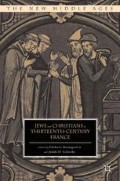Abstract
Discussions of transformations—or lack thereof—in Jewish-Christian polemic in the High Middle Ages traditionally begin with reference to Amos Funkenstein’s 1968 article in Zion, which then appeared in abridged form in Viator and with various modifications in his 1993 book, Perceptions of Jewish History.1 Thus, in 1982, Jeremy Cohen set the stage for his own analysis by expressing reservations about Funkenstein’s thesis;2 in 1996, the first paragraph of Daniel Lasker’s assessment of the twelfth century as a turning point in polemic addresses Funkenstein’s argument;3 and Ora Limor’s recently published article4 contrasting the Barcelona and Majorca disputations also begins with Funkenstein although the thrust of her concerns lies elsewhere.
Access this chapter
Tax calculation will be finalised at checkout
Purchases are for personal use only
Preview
Unable to display preview. Download preview PDF.
Notes
Amos Funkenstein, “Ha-temurot be-vikkuaḥ ha-dat she-bein yehu-dim le-notsrim ba-me’ah ha-yod-bet,” Zion 33 (1968): 122–144;
Amos Funkenstein, “Basic Types of Christian Anti-Jewish Polemics in the Later Middle Ages,” Viator 2 (1971): 373–382.
The final version appears as the major component of chapter 6 of Amos Funkenstein, Perceptions of Jewish History (Berkeley, Los Angeles and Oxford, 1993), 169–219.
Jeremy Cohen, The Friars and the Jews: the Evolution of Medieval anti-Judaism (Ithaca, 1982), 25–32.
Daniel Lasker, “Polemics at the Turning Point: Jewish Evidence from the Twelfth Century,” Harvard Theological Review 89 (1996): 161–173.
Ora Limor, “Polemical Varieties: Religious Disputation in 13th Century Spain,” Iberia Judaica 11 (2010): 55–79.
Yvonne Friedman, ed., Petri Venerabilis Adversus Iudaeorum Inveteratam Duritiem (Brepols, 1985).
John Tolan, Petrus Alfonsi and His Medieval Readers (Gainesville, 1993), 19, 22–25.
Anna Sapir Abulafia, Christians and Jews in the Twelfth-Century Renaissance (London and New York, 1995).
Gilbert Dahan, La polémique chrétienne contre le Judaisme au Moyen Age (Paris, 1991), 115–116.
Avraham Grossman, “Ha-metaḥ ben torah le-‘ḥokhmah’ be-ferush Rashi le-sifrut ha-ḥokhmah she-ba-mikra,” in Teshurah le-‘Amos: asufat meḥkarim be-farshanut ha-mikra muggeshet le-‘Amos Ḥakham, ed. Moshe bar Asher et al. (Alon Shevut, 2007), 13–27, at 23.
For my reaction to Grossman’s overall thesis, see David Berger, “Polemic, Exegesis, Philosophy, and Science: Reflections on the Tenacity of Ashkenazic Modes of Thought” in Jahrbuch des Simon-Dubnow-Instituts 8 (2009): 27–39, reprinted in David Berger, Cultures in Collision and Conversation: Essays in the Intellectual History of the Jews (Boston, 2011), 152–166.
Jacob ben Reuben, Milḥamot ha-Shem, ed. Judah Rosenthal (Jerusalem, 1963),
The relevant chapter of this work has now been translated into English in Wendy Schor-Haim, Jacob ben Reuben’s Sefer Milḥamot Hashem, Chapter One: A Jewish Philosophical Critique of Christianity, (PhD dissertation, New York University, 2012).
Parma manuscript 2749. Substantial sections of the work have been transcribed or published in William K. Herskowitz, Judaeo-Christian dialogue in Provence as reflected in “Milhemet Mitzva” of R. Meir Hameili (D.H.L. dissertation, Yeshiva University, 1974),
and Moshe Blau, Shittat ha-kadmonim ‘al massekhtot nazir, zevaḥim, ‘arakhin, u-temurah, ṿe-sefer milḥemet mitsvah (New York, 1973).
David Berger, The Jewish-Christian Debate in the High Middle Ages: A Critical Edition of the Nitẓẓahon Vetus with an Introduction, Translation, and Commentary (Philadelphia, 1979).
Mordechai Breuer published a one-page appendix to his edition of the Nitsahon Vetus (Sefer nitsaḥon yashan: sefer vikkuaḥ neged ha-notsrim [Ramat Gan, 1978], 194) in which he list ed 33 of these pejorative terms. See too Anna Sapir Abulafia, “Invectives against Christianity in the Hebrew Chronicles of the First Crusade,” in Anna Sapir Abulafia, Christians and Jews in Dispute: Disputational Literature and the Rise of Anti-Judaism in the West (c. 1000–1150) (Aldershot, Hampshire and Brookville, Vermont, 1998).
Funkenstein’s footnote: “B.T. ‘Avoda Zara 2a and the tossafot (sic) ad locum: nir’eh de-ta‘am ha-hetter mi-shum de-‘akum she-beineinu kim lan de-la palḥu la-‘avodat kokhavim. On this issue, see Jacob Katz, Exclusiveness and Tolerance: Studies in Jewish-Gentile Relations in the Middle Ages (Oxford, 1961), 24–47.”
David Berger, “On the Uses of History in Medieval Jewish Polemic against Christianity: The Search for the Historical Jesus,” in Jewish History and Jewish Memory: Essays in Honor of Yosef Hayim Yerushalmi, ed. Elisheva Carlebach, John M. Efron, and David N. Myers (Hanover and London, 1998), 25–39, reprinted in David Berger, Persecution, Polemic, and Dialogue, 139–157, at 142–146.
See Joseph Shatzmiller, La deuxième controverse de Paris: Un chapitre dans la polémique entre chrétiens et juifs au moyen âge (Paris and Louvain, 1994).
The major book-length treatment is Robert Chazan, Barcelona and Beyond: The Disputation of 1263 and Its Aftermath (Berkeley, 1992). For my approach to some of the issues, see my assessment of the book in “The Barcelona Disputation: Review Essay,” AJS Review 20 (1995): 379–388, reprinted in David Berger, Persecution, Polemic, and Dialogue, 199–208.
Editor information
Editors and Affiliations
Copyright information
© 2015 Elisheva Baumgarten and Judah D. Galinsky
About this chapter
Cite this chapter
Berger, D. (2015). How, When, and to What Degree Was the Jewish-Christian Debate Transformed in the Twelfth and Thirteenth Centuries?. In: Baumgarten, E., Galinsky, J.D. (eds) Jews and Christians in Thirteenth-Century France. The New Middle Ages. Palgrave Macmillan, New York. https://doi.org/10.1057/9781137317582_9
Download citation
DOI: https://doi.org/10.1057/9781137317582_9
Publisher Name: Palgrave Macmillan, New York
Print ISBN: 978-1-349-44960-6
Online ISBN: 978-1-137-31758-2
eBook Packages: Palgrave Literature CollectionLiterature, Cultural and Media Studies (R0)

